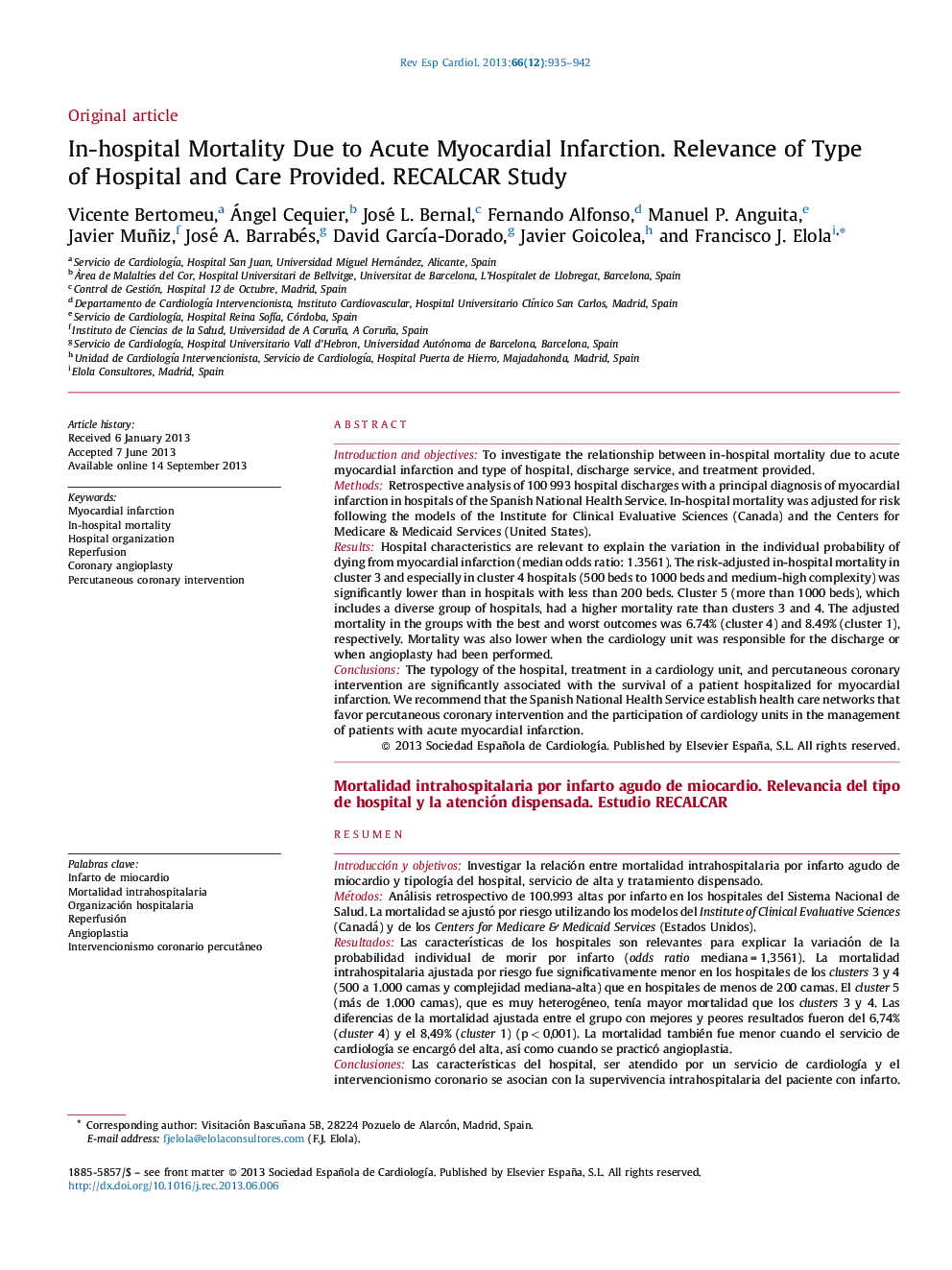| Article ID | Journal | Published Year | Pages | File Type |
|---|---|---|---|---|
| 3017667 | Revista Española de Cardiología (English Edition) | 2013 | 8 Pages |
Introduction and objectivesTo investigate the relationship between in-hospital mortality due to acute myocardial infarction and type of hospital, discharge service, and treatment provided.MethodsRetrospective analysis of 100 993 hospital discharges with a principal diagnosis of myocardial infarction in hospitals of the Spanish National Health Service. In-hospital mortality was adjusted for risk following the models of the Institute for Clinical Evaluative Sciences (Canada) and the Centers for Medicare & Medicaid Services (United States).ResultsHospital characteristics are relevant to explain the variation in the individual probability of dying from myocardial infarction (median odds ratio: 1.3561). The risk-adjusted in-hospital mortality in cluster 3 and especially in cluster 4 hospitals (500 beds to 1000 beds and medium-high complexity) was significantly lower than in hospitals with less than 200 beds. Cluster 5 (more than 1000 beds), which includes a diverse group of hospitals, had a higher mortality rate than clusters 3 and 4. The adjusted mortality in the groups with the best and worst outcomes was 6.74% (cluster 4) and 8.49% (cluster 1), respectively. Mortality was also lower when the cardiology unit was responsible for the discharge or when angioplasty had been performed.ConclusionsThe typology of the hospital, treatment in a cardiology unit, and percutaneous coronary intervention are significantly associated with the survival of a patient hospitalized for myocardial infarction. We recommend that the Spanish National Health Service establish health care networks that favor percutaneous coronary intervention and the participation of cardiology units in the management of patients with acute myocardial infarction.
ResumenIntroducción y objetivosInvestigar la relación entre mortalidad intrahospitalaria por infarto agudo de miocardio y tipología del hospital, servicio de alta y tratamiento dispensado.MétodosAnálisis retrospectivo de 100.993 altas por infarto en los hospitales del Sistema Nacional de Salud. La mortalidad se ajustó por riesgo utilizando los modelos del Institute of Clinical Evaluative Sciences (Canadá) y de los Centers for Medicare & Medicaid Services (Estados Unidos).ResultadosLas características de los hospitales son relevantes para explicar la variación de la probabilidad individual de morir por infarto (odds ratio mediana = 1,3561). La mortalidad intrahospitalaria ajustada por riesgo fue significativamente menor en los hospitales de los clusters 3 y 4 (500 a 1.000 camas y complejidad mediana-alta) que en hospitales de menos de 200 camas. El cluster 5 (más de 1.000 camas), que es muy heterogéneo, tenía mayor mortalidad que los clusters 3 y 4. Las diferencias de la mortalidad ajustada entre el grupo con mejores y peores resultados fueron del 6,74% (cluster 4) y el 8,49% (cluster 1) (p < 0,001). La mortalidad también fue menor cuando el servicio de cardiología se encargó del alta, así como cuando se practicó angioplastia.ConclusionesLas características del hospital, ser atendido por un servicio de cardiología y el intervencionismo coronario se asocian con la supervivencia intrahospitalaria del paciente con infarto. Se recomienda la creación de redes asistenciales en el Sistema Nacional de Salud que favorezcan el intervencionismo coronario y la participación de los servicios de cardiología en el manejo de pacientes con infarto agudo de miocardio.
